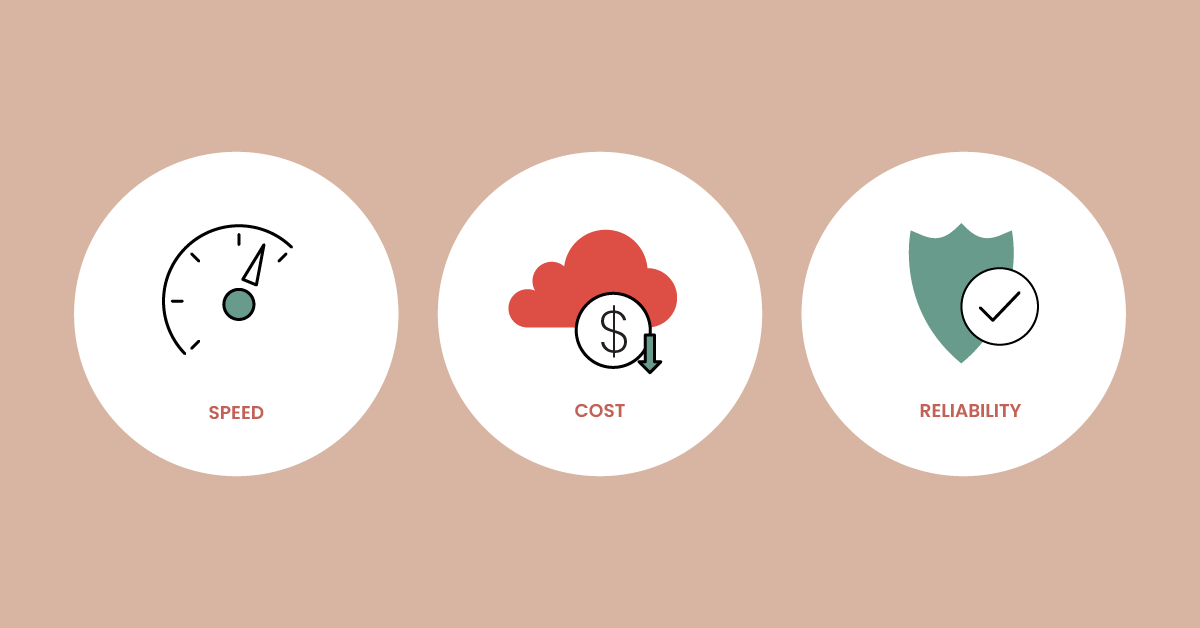Blog
3 Kubernetes Optimization Use Cases: Improved Reliability, Speed, & Cost
By Rich Bentley | Dec 17, 2020

Blog
By Rich Bentley | Dec 17, 2020

StormForge is a platform for performance testing and optimization of apps running on Kubernetes, but what is optimization really? The fact is, it means different things to different organizations. In this blog, we illustrate the top three goals of customers using the StormForge platform.
Some companies need speed to succeed, so they require their Kubernetes applications to run as fast as possible. The costs they incur to achieve a high level of performance is a secondary concern. One such (fictitious*) firm is HF Edge, a boutique investment firm that specializes in high-frequency trading (HFT).
HFT is a method of trading that uses mathematical models and algorithms to analyze multiple markets simultaneously and execute orders based on market conditions. Software-driven systems transact huge numbers of orders in just milliseconds, usually based on tiny movements in a stock’s price throughout the course of a trading day.
HFT is used by many firms today because traders with faster execution speeds are typically more successful than traders with slower execution times. As a result, transaction speed is king among the HFT crowd and firms pursue higher-speed capabilities continuously.
HF Edge has a Kubernetes-based HFT app integrated into its trading system. For their StormForge optimization experiment, they use latency and cost as their goals, with Kubernetes parameters including CPU and memory as their parameters – in other words the variables they will tune to find the optimal result.
In the optimal results found by StormForge, we can see a set of optimal configuration settings (in gold) for the performance and cost goals. While all of the optimal configurations are big improvements over the baseline (represented by the blue triangle), HF Edge chose the highlighted configuration, prioritizing latency improvements over cost savings.

Try StormForge for FREE, and start optimizing your Kubernetes environment now.
Selling automobiles is a tough, competitive and surprisingly low-margin business. A recent Forbes article put the average profit margin for automobile dealers at just 2.4%. Making smaller amounts of profit per unit sold means that dealers need to achieve high sales volume to be successful. It also means that any cost you can squeeze out of your value chain is worth a lot.
One company that has figured out a winning model is CarWizard, a fictitious all-online seller of new and used cars and trucks. CarWizard emphasizes lean inventory management, maintaining the ‘just right’ mix of the number and types of vehicles to meet customer demand. The company also has effective cost-control measures in place, enabling operations to stay profitable.
Being an on-line only operation, one of CarWizard’s early challenges was figuring out how best to provision the core elements of their operation – their website and their inventory management system. The business experiences significant fluctuations in customer demand and web traffic flows. Some of these are due to natural day-of-week and end-of-month buying cycles. But other peaks and valleys are tied to less predictable factors, such as the overall state of the economy.
Both the eCommerce functionality of the website and its inventory management are cloud-architected, Kubernetes-based applications. To ensure performance, the team initially set resource requests and limits higher than was probably needed to be safe. They realized that they were probably over-provisioning, but how to figure out the right configurations to handle peak traffic loads with acceptable performance while minimizing cloud costs?
CarWizard found the dynamic scalability and flexibility they needed to keep costs well under control with StormForge. In this case, they prioritized cost over latency, choosing a configuration that would reduce costs from their baseline configuration by 51% with negligible change to latency.

PrecisionMed sells refrigeration units to national drugstore chains for the storage of temperature-sensitive medications and vaccines. Many medications and vaccines need to be kept at or below room temperature to maintain their effectiveness. Insulin, for example, must be kept below 86 degrees Fahrenheit at all times. If not, its effectiveness drops off dramatically.
Insulin is not an outlier. In fact, according to Pharmacy Times, all of the top 10 medications prescribed by doctors today have upper temperature limits. Vaccines tend to be even more temperature-sensitive, with many requiring continual refrigeration. If proper temperatures are not maintained, drugstores and other involved entities can incur significant losses and be exposed to major liability risks.
One of the most important components of the refrigeration units PrecisionMed sells to drugstores is an integrated, temperature-monitoring application. The Kubernetes-based app alerts store managers or pharmacists when the temperature of a unit is starting to fall out of the desired range. But the app does more; it uses IoT-supplied real-time temperature data to monitor temperature-controlled supply chains that include all equipment used to transport and store medications and vaccines from the time of manufacture through to dispensing or administering them.
In this situation, performance and cost are lesser concerns than stability and reliability. PrecisionMed uses StormForge to ensure app deployments are stable before they are released to production. The StormForge machine learning engine identifies “high-risk” configurations – those most likely to fail in production under realistic load scenarios. In the example shown below, StormForge tested 40 different configurations before a recent deployment and found that 26 of them were high-risk.

Different businesses have different operational imperatives when it comes to leveraging the cloud and Kubernetes applications. For some, like certain Wall Street firms, it’s all about being fastest. For companies operating in low-margin segments, their K8s apps need to help them to run lean. And for others, it’s all about stability and reliability, no matter what.
Whatever the business need is, StormForge can help to ensure that need is always met.
*Author’s Note: While the companies used as examples in this post are fictitious, they are composites of actual StormForge users.
We use cookies to provide you with a better website experience and to analyze the site traffic. Please read our "privacy policy" for more information.